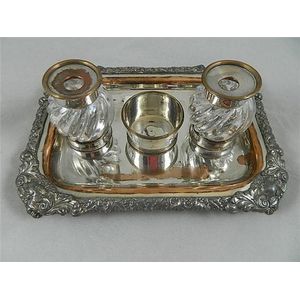Sheffield Plate Candlewick Trimmer with Tray
A quality Sheffield plate Candlewick Trimmer with tray, 1820s, with maker's mark for Gilbert, the heavy 'Close' plated set cast in the rococo manner with shells and leafy embellishments to the tray and with engraved enrichments, the wick trimmer with King's pattern type scissors, marked to throat, length 24 cm, width 10 cm, (tray)
You must be a subscriber, and be logged in to view price and dealer details.
Subscribe Now to view actual auction price for this item
When you subscribe, you have the option of setting the currency in which to display prices to $Au, $US, $NZ or Stg.
This item has been sold, and the description, image and price are for reference purposes only.
- Close Plate - Generally made in Birmingham in the 18th century and the first half of 19th century, close plate consists of silver foil soldered onto a steel base that had been dipped into tin, and was used for items such as candle snuffers, knife blades, buckles and spurs requiring greater strength than fused plate. With advances in technology, the process was obsolete by the mid 19th century.
- Sheffield Plate - Sheffield plate was the first commercially viable method of plating metal with silver. The method of plating was invented by Thomas Boulsover, a Sheffield Cutler, in 1743 and involved sandwiching an ingot of copper between two plates of silver, tightly binding it with wire, heating it in a furnace and then milling it out in to sheet, from which objects could be made.
Originally used by its inventor to make buttons, the potential of the material was quickly realised, and soon it was being used to fashion boxes, salvers and jugs, and not long after that candlesticks and coffee pots, and other traditional tableware.
Although there was a considerable saving in the amount of silver used, Old Sheffield Plate manufacture was more labour intensive than solid silver, meaning higher labour costs. This meant that Old Sheffield Plate was very much a luxury product, and only available to the very wealthy.
The thickness of the silver means that many 18th century Sheffield Plate pieces still have a good layer of silver, while electroplated pieces (EPNS), may have been replated several times over their lifetime. Where the silver has worn off the Sheffield plate the soft glow of the copper base can be seen underneath. However this is not an infallible guide that the piece is Sheffield Plate, as many EPNS items were also plated on to a copper base.
Most Sheffield plate items are unmarked, whereas most elecroplated items display manufacturers names or marks, quality indications such as "A1", "EP", together with pattern or model numbers.
Sheffield plate was made commercially between 1750 and 1850. - Close Plated (silver Plating) - Close plating is a process where a very thin layer of silver is deposited onto a base metal, usually using an electrolytic process, but sometimes electroless as well. The thickness of the silver coating is usually between 0.05 and 0.1 microns. It is used to enhance the appearance of the base metal.
It is similar to the process of silver plating, where a thin layer of silver is deposited onto a base metal using an electrolytic process. This process is also generally used to improve the appearance of the base metal or to protect it from tarnishing. The thickness of the silver coating can vary depending on the application, but it is usually between 0.25 and 2 microns.
Close plating and silver plating are similar processes in that they both involve coating an object with a thin layer of silver. However close plating applies a much thinner layer of silver. The term "close" is used because the layer of silver is so thin that the base metal color is still visible through it.
This item has been included into following indexes:
Visually similar items

Old Sheffield plate inkstand with two bottles (1830-1845)
Sold by
in
for
You can display prices in $Au, $US, $NZ or Stg.

Sterling silver cased condiment set, Birmingham 1914-15-16-17
Sold by
in
for
You can display prices in $Au, $US, $NZ or Stg.

A pair of silver plate entree dishes.
Sold by
in
for
You can display prices in $Au, $US, $NZ or Stg.

Sterling silver Gainsborough Angels pin dish, Birmingham 1903
Sold by
in
for
You can display prices in $Au, $US, $NZ or Stg.
